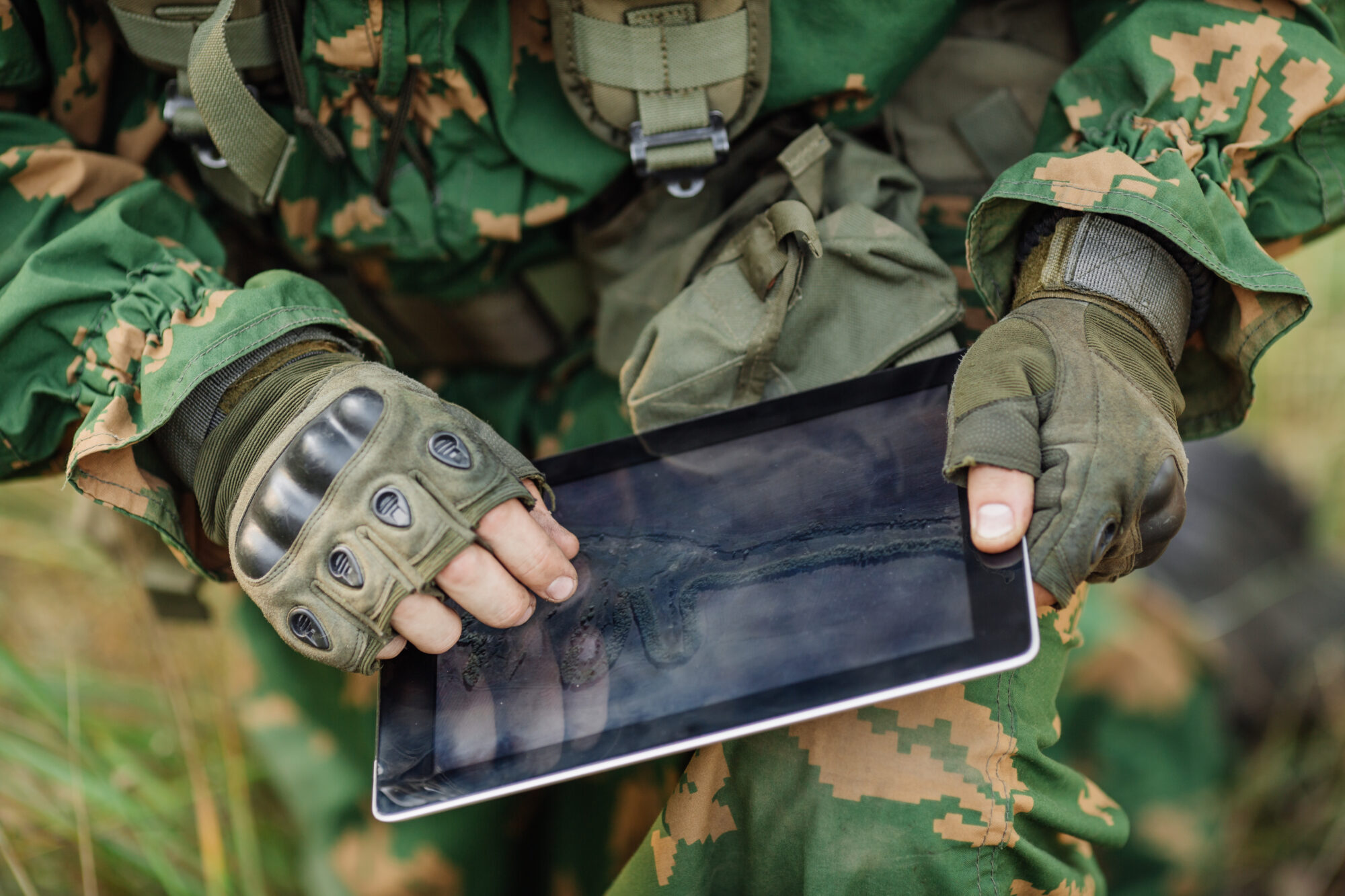Integrating Augmented Reality (AR) technology into various sectors has significantly improved operational efficiency, training, and maintenance processes. Augmented Reality is revolutionizing how maintenance and repairs are conducted in the military industry, especially in remote or challenging environments.
This article explores the impact of AR technology on remote repairs in arms maintenance, detailing the main problems faced in the sector, the standards and regulations governing military maintenance, the concept of remote repairs, and the pivotal role of AR in enhancing these processes.
Augmented Reality (AR) in Military Maintenance
Augmented Reality (AR) is revolutionizing military maintenance, offering solutions to some of the most pressing challenges military organizations face worldwide. By overlaying virtual and real objects, AR provides a dynamic toolset that enhances maintenance operations’ efficiency, accuracy, and safety. Its impact is profound, transforming traditional maintenance methodologies into interactive, real-time processes more aligned with modern military operations’ complexities and demands.
Enhanced Diagnostic Capabilities
AR technology can significantly improve the diagnostic process in military maintenance. Technicians can more easily identify issues and understand complex systems by superimposing digital data directly onto the physical equipment, such as schematics and sensor readings. This real-time integration of data aids in quicker, more accurate diagnostics, reducing downtime and ensuring equipment is operational when needed.
Remote Assistance and Collaboration
One of the most significant benefits of Augmented Reality in military maintenance is its ability to facilitate remote assistance. Experts worldwide can view the same physical equipment as a technician on-site through an AR interface, providing real-time guidance, instructions, and support. This capability is invaluable for conducting repairs in remote or dangerous locations where expert assistance is unavailable.
Training and Skill Development
AR technology offers innovative ways to train military maintenance personnel. Through AR-based training programs, technicians can practice maintenance tasks on virtual equipment models, gaining valuable experience without the risk of damaging actual hardware. This hands-on approach to learning helps develop proficiency and confidence, ensuring that personnel are better prepared for the complexities of real-world maintenance tasks.
Streamlining Maintenance Procedures
AR can streamline maintenance procedures by providing step-by-step guidance on servicing equipment. This guidance can include animations, instructions, and safety warnings, helping technicians perform tasks more efficiently and with fewer errors. By reducing the time and effort required for maintenance, Augmented Reality technology allows for maintaining high readiness levels and operational capability.
Enhanced Safety
Safety is paramount in military maintenance, and AR can be crucial in ensuring it. By providing virtual warnings and safety instructions in real-time, Augmented Reality helps technicians avoid hazardous situations. Additionally, AR can simulate dangerous scenarios for training, allowing personnel to practice responding to emergencies in a safe, controlled environment.
Cost Reduction and Sustainability
By improving the efficiency and accuracy of maintenance operations, Augmented Reality technology can help reduce costs associated with repairs, downtime, and training. Furthermore, the ability to conduct remote diagnostics and repairs minimizes the need for expert personnel to travel, leading to reductions in logistics costs and environmental impact.
Adaptive Maintenance Strategies
AR enables more adaptive maintenance strategies, such as predictive maintenance, by integrating real-time data analytics and machine learning. Technicians can receive alerts about potential equipment failures before they occur, allowing for preemptive repairs that prevent downtime and extend the lifespan of military assets.
The role of Augmented Reality in military maintenance is transformative, offering a suite of tools that address longstanding challenges in the field. As AR technology continues to evolve, its integration into military operations is expected to deepen, further enhancing military maintenance practices’ effectiveness, safety, and sustainability.

presentation to try
Nsflow in action
Remote Repairs via AR in the Arms Industry
According to the report “Military Aviation Maintenance, Repair, and Overhaul Market Size“, the size of the global market for military aviation services, repairs and overhauls was valued at USD 39.34 billion in 2022. The estimated value by 2031 is as much as USD 47.85 billion. This is why the application of Augmented Reality (AR) in remote repairs, especially within the arms industry, represents a significant organizational advancement with profound implications.
AR technology can overlay digital information, such as images, data, and instructions, onto the real-world environment, which can be viewed through AR glasses or mobile devices. In the context of the arms industry, this has several key applications and benefits.
Applications and Benefits
- Remote Assistance and Training: Experts worldwide can provide real-time guidance and support to technicians on the ground, overlaying instructions directly onto the equipment being serviced. This type of assistance is a huge benefit when it comes to frontline equipment repairs. Enables direct repair through secure connections to an expert. By implementing AR, the arms equipment can be repaired immediately, without additional logistics costs.
- Maintenance and Repairs: AR can display step-by-step repair instructions over the physical components, helping technicians to identify and fix issues more efficiently. This is particularly useful for complex or rarely serviced equipment, where traditional manuals may be less effective. This solution is also applicable during military operations, when the military receives equipment for operations from other manufacturers.
- Quality Assurance and Inspection: AR can assist in the inspection process by overlaying the expected measurement specifications or highlighting areas of concern on the physical equipment. This can help ensure that repairs and maintenance meet the required standards.
- Training and Simulation: AR can be used to simulate maintenance and repair scenarios for training purposes without actual equipment. This allows for safe and cost-effective training on maintenance procedures, potentially including rare or dangerous situations that are difficult to replicate in real life.
- Inventory Management: By scanning barcodes or QR codes with an AR device, technicians can instantly access a wealth of information about parts, including specifications, stock levels, and even order replacements, without leaving the repair site.
Challenges and Considerations
While the benefits are significant, there are also challenges and considerations in implementing AR for remote repairs in the arms industry:
- Security and Confidentiality: The arms industry deals with sensitive and classified information. It is paramount to ensure that data transmitted via AR is secure and that only authorized personnel can access it.
- Technology Adoption and Integration: Integrating AR into existing systems and processes can be complex and costly. It requires significant investment in technology and training.
- Hardware and Software Reliability: The effectiveness of AR for remote repairs depends on the reliability of the hardware and software used. Any malfunction could hinder the repair process rather than facilitate it.
- Regulatory Compliance: AR in the arms industry must comply with national and international arms manufacturing and repair regulations.

AR vs Military Maintenance Standards and Regulations
Standards and regulations in military maintenance are critical for ensuring the operational readiness, safety, and longevity of military equipment and assets. These standards encompass many processes, procedures, and criteria designed to maintain or restore military equipment to a state where it can perform its required function.
To integrate Augmented Reality (AR) into the existing framework of standards and regulations for military maintenance, it’s essential to consider how AR technology can enhance each aspect of maintenance operations.
The specifics can vary significantly depending on the country, branch of the military (e.g., army, navy, air force), type of equipment (e.g., vehicles, aircraft, naval ships), and the level of maintenance (e.g., field-level, depot-level). However, several common themes and components are found across most military maintenance standards and regulations:
Technical Manuals and Documentation
- Detailed manuals and documentation provide each piece of equipment’s technical specifications, maintenance procedures, and safety guidelines. These documents are essential for ensuring consistency and accuracy in maintenance practices.
AR implementation: Augmented Reality can revolutionize technical manuals and documentation by providing interactive, digital visual elements and their components. AR can offer step-by-step maintenance instructions overlaid directly onto the equipment, improving comprehension and reducing errors. Additionally, AR-enabled device maintenance can ensure accurate and secure digital documentation.
Scheduled Maintenance
- Preventive maintenance schedules are rigorously defined to ensure equipment is serviced regularly before potential failures occur. This includes routine inspections, servicing, and replacement of parts at predetermined intervals.
AR implementation: AR applications can assist in scheduled maintenance by visualizing the maintenance schedule and procedures directly on the equipment, guiding technicians through each step, and verifying completion.
Condition-Based Maintenance
- Beyond scheduled maintenance, many military organizations are moving towards condition-based maintenance, which relies on real-time data and diagnostics to monitor the condition of equipment and perform maintenance as needed based on actual wear and performance rather than on a set schedule.
AR implementation: Integrating AR with real-time diagnostic data allows technicians to visualize the condition of equipment components in real-time, identifying wear and potential failures more effectively. This can be achieved through AR interfaces that overlay data on the physical equipment, making diagnostics more intuitive.
Quality Assurance and Control
- Strict quality assurance and control measures are in place to ensure that all maintenance activities meet or exceed specific standards. This includes inspecting and testing equipment before it is returned to operational status.
AR implementation: AR can aid in quality assurance and control by providing visual confirmation of completed tasks and highlighting deviations from required standards. For example, AR can overlay the correct configurations and specifications on the equipment, allowing for immediate verification.
Training and Certification
- Personnel involved in military maintenance must undergo specialized training and, in many cases, achieve certification to perform maintenance tasks. This ensures that technicians have the necessary skills and knowledge to maintain complex military equipment safely and effectively.
AR implementation: AR’s role in training and certification becomes significant, offering immersive, hands-on training simulations replicating real-life scenarios. This can accelerate learning, improve retention, and ensure technicians are fully prepared for the complexities of actual maintenance tasks.
Health, Safety, and Environmental Regulations
- Maintenance operations must comply with health, safety, and environmental regulations to protect personnel and the environment from hazards associated with military maintenance activities, such as exposure to hazardous materials or pollutants.
AR implementation: AR can enhance safety training by simulating hazardous scenarios in a controlled environment and teaching proper materials handling and emergency procedures without risk. It can also ensure compliance by visually guiding technicians through safe procedures and disposal methods.
Compliance with International Standards
- Military maintenance standards may sometimes align with or incorporate international standards (such as ISO) to ensure compatibility and interoperability with equipment and forces from other countries.
AR implementation: AR can ensure compliance with international standards by providing maintenance personnel with up-to-date guidelines and procedures from international bodies directly through AR interfaces.
These standards and regulations are subject to continuous review and improvement to adapt to technological advancements, lessons learned from operational experiences, and changing tactical and strategic requirements. Ensuring strict adherence to these standards is vital for maintaining the effectiveness and readiness of military forces.
Integrating AR roles into military maintenance standards and regulations can significantly enhance military equipment’s operational readiness, safety, and longevity. AR offers a transformative approach to maintenance, making it more efficient, accurate, and safe, ensuring that military forces remain at the peak of readiness and effectiveness.


